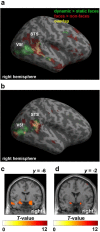Top-down control of visual responses to fear by the amygdala
- PMID: 24174677
- PMCID: PMC6618361
- DOI: 10.1523/JNEUROSCI.2992-13.2013
Top-down control of visual responses to fear by the amygdala
Abstract
The visual cortex is sensitive to emotional stimuli. This sensitivity is typically assumed to arise when amygdala modulates visual cortex via backwards connections. Using human fMRI, we compared dynamic causal connectivity models of sensitivity with fearful faces. This model comparison tested whether amygdala modulates distinct cortical areas, depending on dynamic or static face presentation. The ventral temporal fusiform face area showed sensitivity to fearful expressions in static faces. However, for dynamic faces, we found fear sensitivity in dorsal motion-sensitive areas within hMT+/V5 and superior temporal sulcus. The model with the greatest evidence included connections modulated by dynamic and static fear from amygdala to dorsal and ventral temporal areas, respectively. According to this functional architecture, amygdala could enhance encoding of fearful expression movements from video and the form of fearful expressions from static images. The amygdala may therefore optimize visual encoding of socially charged and salient information.
Figures





References
-
- Brett M, Penny WD, Kiebel SJ. Introduction to random field theory. In: Frackowiak RSJ, Friston KJ, Frith C, Dolan R, Price CJ, Zeki S, Ashburner J, Penny WD, editors. Human brain function. Ed 2. San Diego: Academic; 2003.
-
- Calder AJ. Does facial identity and facial expression recognition involve separate visual routes? In: Calder AJ, Rhodes G, Johnson M, Haxby JV, editors. The Oxford handbook of face perception. Oxford: Oxford UP; 2011.
Publication types
MeSH terms
Grants and funding
LinkOut - more resources
Full Text Sources
Other Literature Sources
